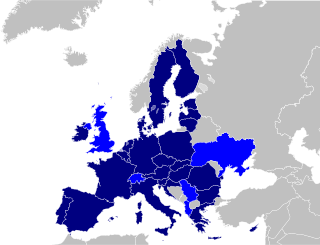Related Research Articles

Elizabeth Ann Gilmour is an American child safety activist and commentator for ABC News. She gained national attention at age 14 when she was abducted from her home in Salt Lake City by Brian David Mitchell. Mitchell and his wife, Wanda Barzee, held Smart captive for nine months until she was rescued by police officers on a street in Sandy, Utah.

An Amber alert or a child abduction emergency alert is a message distributed by a child abduction alert system to ask the public for help in finding abducted children. The system originated in the United States of America.

Juvenile delinquency, also known as juvenile offending, is the act of participating in unlawful behavior as a minor or individual younger than the statutory age of majority. These acts would otherwise be considered crimes if the individuals committing them were older. The term delinquent usually refers to juvenile delinquency, and is also generalised to refer to a young person who behaves an unacceptable way.

A missing person is a person who has disappeared and whose status as alive or dead cannot be confirmed as their location and condition are unknown. A person may go missing through a voluntary disappearance, or else due to an accident, crime, death in a location where they cannot be found, or many other reasons. In most parts of the world, a missing person will usually be found quickly. Criminal abductions are some of the most widely reported missing person cases.
NISMART or the National Incidence Studies of Missing, Abducted, Runaway and Throwaway Children, was a research project supported by the United States Department of Justice. It was enacted to address the 1984 Missing Children's Assistance Act. This required the Office of Juvenile Justice and Delinquency Prevention (OJJDP) to conduct periodic national incidence studies to determine the actual number of children reported missing and the number recovered. The first study, NISMART-1 in 1988 categorized the various missing children reports and estimated the number of missing and recovered children in each. In 1999, a second study dubbed NISMART-2 was initiated. The two studies cannot be compared against each other due to categorizing techniques being distinct in each study. Also, NISMART-2 interviewed youth directly whereas NISMART-1 did not.
Court Appointed Special Advocates (CASA) is a national association in the United States that supports and promotes court-appointed advocates for abused or neglected children. CASA are volunteers from the community who complete training that has been provided by the state or local CASA office. They are appointed by a judge, and their role is to gather information and make recommendations in the best interest of the child, keeping the child's personal wishes in mind.
The National Center for Missing & Exploited Children (NCMEC) is a private, nonprofit organization established in 1984 by the United States Congress. In September 2013, the United States House of Representatives, United States Senate, and the President of the United States reauthorized the allocation of $40 million in funding for the organization as part of Missing Children's Assistance Reauthorization Act of 2013. The current chair of the organization is Jon Grosso of Kohl's. NCMEC handles cases of missing minors from infancy to young adults through age 20.
Stranger danger is the idea or warning that all strangers can potentially be dangerous. The phrase is intended to encapsulate the danger associated with adults whom children do not know. The phrase has found widespread usage and many children will hear it during their childhood. Many books, films and public service announcements have been devoted to helping children remember this advice.

The American juvenile justice system is the primary system used to handle minors who are convicted of criminal offenses. The system is composed of a federal and many separate state, territorial, and local jurisdictions, with states and the federal government sharing sovereign police power under the common authority of the United States Constitution. The juvenile justice system intervenes in delinquent behavior through police, court, and correctional involvement, with the goal of rehabilitation. Youth and their guardians can face a variety of consequences including probation, community service, youth court, youth incarceration and alternative schooling. The juvenile justice system, similar to the adult system, operates from a belief that intervening early in delinquent behavior will deter adolescents from engaging in criminal behavior as adults.
The Child Abuse Prevention and Treatment Act of 1988 provides financial assistance for demonstration programs for the prevention, identification, and treatment of child abuse and neglect and to establish a National Center on Child Abuse and Neglect. Additionally, it identifies the federal role in supporting research, evaluation, technical assistance, and data collection activities; it established the Office on Child Abuse and Neglect in the United States Children's Bureau; and mandates the National Clearinghouse on Child Abuse and Neglect Information. It also sets forth a minimum definition of child abuse and neglect.
The Morgan P. Hardiman Child Abduction and Serial Murder Investigative Resources Center (CASMIRC) is a unit of the FBI's National Center for the Analysis of Violent Crime (NCAVC) that provides resources, advice, and training to local agencies working on cases of missing, kidnapped, or murdered children and serial murders. Congress established CASMIRC under as part of Public Law 1998 section 105-314, the Protection of Children From Sexual Predators Act aiming to reduce crime involving child abductions, mysterious disappearances of children, child homicide, and serial murder.
Juvenile law pertains to those who are deemed to be below the age of majority, which varies by country and culture. Usually, minors are treated differently under the law. However, even minors may be prosecuted as adults.
Juvenile delinquency in the United States refers to crimes committed by children or young people, particularly those under the age of eighteen.
A child abduction alert system is a tool used to alert the public in cases of worrying or life-threatening disappearances of children.
Child abduction or child theft is the unauthorized removal of a minor from the custody of the child's natural parents or legally appointed guardians.

116 000 is the European missing children hotline number. It was the first harmonised service of social value to be adopted by the European Union. The 116 000 hotline provides free, immediate life saving support when children go missing.

The United States incarcerates more of its youth than any other country in the world, through the juvenile courts and the adult criminal justice system, which reflects the larger trends in incarceration practices in the United States. In 2010, approximately 70,800 juveniles were incarcerated in youth detention facilities alone. As of 2006, approximately 500,000 youth were brought to detention centers in a given year. This data does not reflect juveniles tried as adults. As of 2013, around 40% were incarcerated in privatized, for-profit facilities.
Jerry Regier was the Deputy Assistant Secretary for Human Services Policy in the U.S. Department of Health and Human Services from 2005–2007. He provides leadership on policy analysis and development in human services and on research under the Assistant Secretary for Planning and Evaluation (ASPE) for Secretary Mike Leavitt.
International Missing Children's Day is an international day celebrated on May 25th, the same day as the United States' National Missing Children's Day designated by Ronald Reagan in 1983. It is a day dedicated to raising awareness about the issue of missing children, highlighting the efforts made to find and bring them back safely, and supporting the families affected by these tragedies.
Youth intervention is a practice within the field of youth services. This practice is designed to intervene when young people are at risk of or beginning to make poor decisions that can have lifelong negative impacts. Youth intervention is intended to support academic achievement and prevent juvenile delinquency.
References
- ↑ Take Root official web site home page Archived 2007-10-04 at the Wayback Machine See note in lower left-hand corner of home page; retrieved October 19, 2007
- ↑ Office of Juvenile Justice and Delinquency Prevention Programs government web site retrieved October 19, 2007
- ↑ Practitioner Resources web site on grants retrieved October 19, 2007
- ↑ "When The Missing Return, Recovery Is Long, Too". NPR.org. Retrieved 2016-11-25.
- 1 2 3 Broughton, Daniel D. (2015-09-10). Perspectives on Missing Persons Cases. Carolina Academic Press. ISBN 9781611635164.
- ↑ "When The Missing Return, Recovery Is Long, Too". NPR . Archived from the original on 2020-08-14.
- ↑ Take Root official web site
- ↑ "Family abduction takes bitter toll on victims". msnbc.com. 2006-05-15. Archived from the original on March 5, 2016. Retrieved 2016-11-25.
- Belzman, Josh, "Victims of Family Abduction Speak Out", MSNBC.com, May 14.
- Feeg, Veronica, "What is Not Part of the Child Abduction News Story?", Journal of Pediatric Nursing (Jannetti) 33 (1), Jan-Feb 2007.
- Office of Juvenile Justice & Delinquency Prevention, What About Me? Coping With the Abduction of a Brother or Sister (published 2007).
- Hammer, Nancy, "The Myths and Truths of Family Abduction", USA Today, Sept 2003.
- Pressley, Sue Ann, "Left in a Life of Uncertainty", The Washington Post, June 6, 2006:A01.
- Halloran, Liz, "When the Missing Return Recovery is Long Too", NPR, May 15, 2013